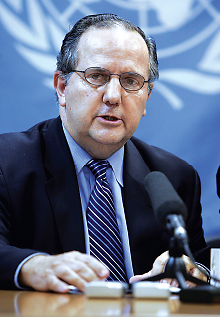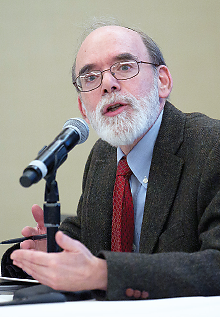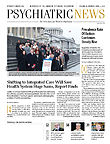Involuntary psychiatric treatment is always torture, except, apparently, when it is not, according to a report prepared for the United Nations Human Rights Council (UNHRC).
On one hand, the report, “Torture in Healthcare Settings,” calls for “an absolute ban on all forced and nonconsensual medical interventions against persons with disabilities, including the nonconsensual administration of psychosurgery, electroshock and mind-altering drugs such as neuroleptics, the use of restraint and solitary confinement, for both long- and short-term application.”
On the other hand, said the report’s author, UNHRC Special Rapporteur Juan Mendez, J.D., in a letter to the leaders of APA and the World Psychiatric Association (WPA): “I did not mean to propose an absolute ban on nonconsensual interventions (including institutionalization and restraints) under any and all circumstances.”
If that sounds confusing, that may be because it reflects a view of mental health practice that is unfamiliar to most clinicians.
“My first impression is that it is a document written by someone or some group with little or no contact with psychiatry, with psychiatric disorders, or psychiatric treatment,” said former APA President Paul Appelbaum, M.D., the Dollard Professor of Psychiatry, Medicine, and Law at Columbia University College of Physicians and Surgeons. Appelbaum helped draft the APA/WPA reply to the UNHRC.
In the end, however, the report may have little real significance, admitted Mendez, a visiting professor of law at the American University–Washington College of Law in Washington, D.C.
“The whole point is to generate a discussion,” he told Psychiatric News.
The report, submitted in February 2013, generated enough discussion that American University recently published a 346-page book that included both the report and 24 articles commenting on its findings. Among them is a point-by-point response from APA President Jeffrey Lieberman, M.D.; APA CEO and Medical Director Saul Levin, M.D., M.P.A.; and WPA President Pedro Ruiz, M.D.
Serious Harm Could Result if Adopted
“The APA and WPA are greatly concerned that the adoption of these perspectives and recommendations may be detrimental to the interests of individuals with serious mental disorders, and likely to cause serious harm to the very groups it intends to protect,” wrote the three leaders.
More broadly, the report also covers unacceptable practices such as compulsory detention for drug users, “abuse and mistreatment of women seeking reproductive health services,” denial of pain treatment, involuntary gender reassignment surgery, and discrimination based on sexual orientation or medical or disability status—including psychosocial disabilities.
“We found situations in health care settings that cross the line into prohibited treatment of people that the [United Nations] torture convention calls torture or cruel or degrading treatment,” said Mendez. “So we tried to more systematically explore practices around the world that could conceivably cross that line.”
Involuntary civil commitment, treatment authorized by a guardian for individuals who cannot consent, or the use of restraint sometimes cross that line, he said.
Mendez included neither APA nor WPA trepresentatives on his panel of experts while gathering information for the report.
“We don’t invite institutionally; we invited individuals we thought could give us some advice,” he said. “Some people were users of psychiatry with critical views, and others took positions closer to the APA/WPA letter.”
Two individuals represented groups identifying themselves as “survivors of psychiatry.” At least two other individuals appearing on the list of experts Mendez sent to Psychiatric News said they were invited to testify but never actually did so.
“The report is not as absolutist as it appears at first blush,” suggested one participant, Eric Rosenthal, J.D., founder and executive director of Disability Rights International, in an interview. “The clarifying letter helps.”
Therapeutic Intent Should Be Examined
The severity, duration, and context of an intervention must also be considered, said Rosenthal, speaking for himself. “Therapeutic intent cannot justify a practice if it rises to the level of pain and suffering. For example, short-term restraints may be acceptable, but long-term restraints cross the line into torture.”
The report was an important contribution that contained an important cautionary note, he said: “No matter what the therapeutic intent, there was a limitation on state power to inflict pain.”
Mendez said he regretted “some inartful wording” or “an editing mistake” in his report. “I do agree that some involuntary interventions are warranted and legal under international law.”
‘Slippery Language’ Cited
“There’s a lot of slippery language in his report,” said Appelbaum. “All the recommendations flow from the first step: the redefinition of torture to include involuntary hospitalization or treatment when people have been found incompetent to make decisions or are dangerous to self or others. Once you say it’s ‘torture,’ then there’s no defense; the case is closed.”
The APA/WPA view, Mendez acknowledged, “may be the standard of the medical profession and, if it is, I’m glad to hear it. However, around the world—in terms of law—in most jurisdictions, the standard is much looser and allows anyone of ‘unsound mind’ for any involuntary treatment.”
Most of the examples of mistreatment of psychiatric patients are drawn from countries outside North America. Mendez did not visit the United States in preparing his report, because the special rapporteur must be invited by a government. Mendez has asked the Department of State for an invitation to visit U.S. prisons, immigration detention centers, and mental health institutions, but has not yet received a response, he said.
“It was important for APA to respond directly and challenge the misconceptions on which the report is based,” said Appelbaum. “But there’s a broader point here: It would be better for organized psychiatry to be at the table when such reports are being formulated to counter misleading arguments and analogies when they are made, rather than being forced into a reactive position after their release.” ■
“Report of the Special Rapporteur on Torture and Other Cruel, Inhuman, or Degrading Treatment or Punishment, Juan E. Mȳndez” can be accessed
here. “Torture in Healthcare Settings: Reflections on the Special Rapporteur on Torture’s 2013 Thematic Report,” published by American University, which includes the joint APA/WPA response, is posted
here.


